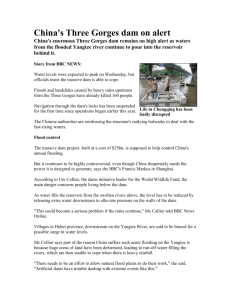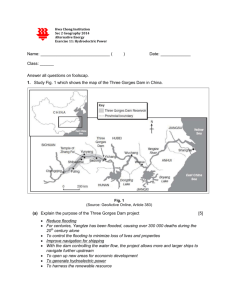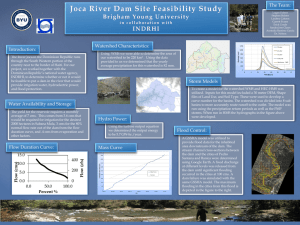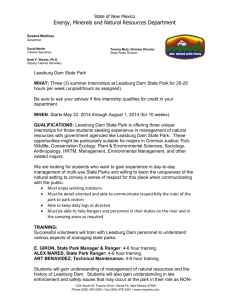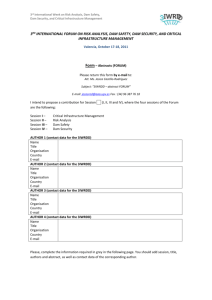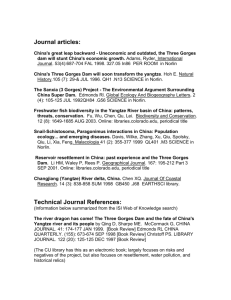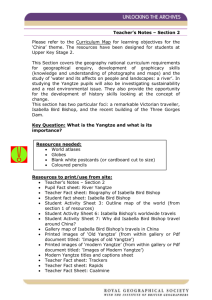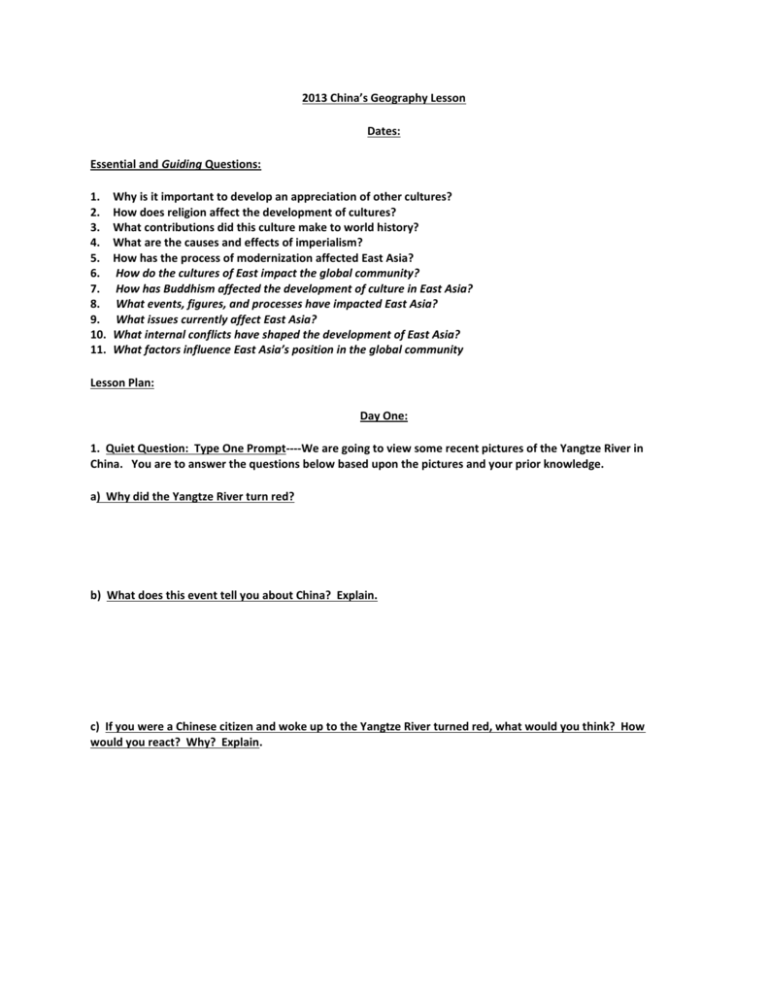
2013 China’s Geography Lesson
Dates:
Essential and Guiding Questions:
1.
2.
3.
4.
5.
6.
7.
8.
9.
10.
11.
Why is it important to develop an appreciation of other cultures?
How does religion affect the development of cultures?
What contributions did this culture make to world history?
What are the causes and effects of imperialism?
How has the process of modernization affected East Asia?
How do the cultures of East impact the global community?
How has Buddhism affected the development of culture in East Asia?
What events, figures, and processes have impacted East Asia?
What issues currently affect East Asia?
What internal conflicts have shaped the development of East Asia?
What factors influence East Asia’s position in the global community
Lesson Plan:
Day One:
1. Quiet Question: Type One Prompt----We are going to view some recent pictures of the Yangtze River in
China. You are to answer the questions below based upon the pictures and your prior knowledge.
a) Why did the Yangtze River turn red?
b) What does this event tell you about China? Explain.
c) If you were a Chinese citizen and woke up to the Yangtze River turned red, what would you think? How
would you react? Why? Explain.
2. Class: Now Ms. Barben is going to read aloud the newspaper article below. As she does, you should be
doing Active Reading strategies. Then you will go back and using a different color writing utensil, add on to your
initial answers to the questions.
Yangtze River Runs Mysteriously Red: Officials unsure the cause---Sept 2012
By Life's Little Mysteries Eli MacKinnon
A stretch of China's longest river has abruptly turned the color of tomato juice, and officials say they don't know
why. Residents of the southwestern city of Chongqing first noticed that the Yangtze River, called the "golden
waterway," had a spreading stain on its reputation Thursday (Sept. 6).
Though the bright-red water was concentrated around Chongqing, Southwest China's largest industrial center, it
was also reported at several other points along the river, according to ABC News.
Investigators have yet to determine a cause, but the Telegraph reports that environmental officials are
considering industrial pollution and silt churned up by recent upstream floods as possible sources for the color.
One natural explanation for red water that can likely be ruled out is color-producing microorganisms, according
to Emily Stanley, a professor of limnology (the study of inland waters) at the University of Wisconsin.
"When water turns red, the thing a lot of people think of first is red tide," Stanley told Life's Little Mysteries.
"But the algae that causes red tide is a marine group and not a freshwater group, so it's highly, highly unlikely
that this is a red-tide-related phenomenon."
Fresh water does occasionally turn blood-red for biological reasons (a lake that turned red during a drought in
Texas last summer led to talk of the end times), but Stanley said this is most often due to incursions of colorproducing bacteria that arrive when a body of water has less oxygen than normal. Because rivers move
constantly, struggling and mixing with the air above them as they go, they rarely ever get the oxygen
deficiencies necessary for a life-based red dye job.
After reviewing a few images of Chongqing's shockingly red river, Stanley put her money on a man-made cause.
"It looks like a pollutant phenomenon," she said. "Water bodies that have turned red very fast in the past have
happened because people have dumped dyes into them."
An industrial dye dump was in fact the explanation when an urban stretch of another Chinese river, the Jian,
turned crimson last December. Investigators traced the color back to a chemical plant that they said had been
illegally producing red dye for firework wrappers.
Still, Stanley says she can't rule out the other possibility officials are now reportedly investigating: an upstream
influx of silt. Her instinct, though, is that red clay would be more likely. "China is well known for having areas
with a lot of steep hill sides and a lot of land use practices that promote soil erosion and soil going into rivers,"
she said. "You can get red-colored clays that wouldn't be a whole lot different from having a big dose of dye go
in there. But if that's the cause I'd imagine there would have had to be a huge storm or a huge amount of clay go
into the system." Taking another look at the Campbell's-hued Yangtze, she said, "It looks really industrial
somehow."
Copyright 2012 Lifes Little Mysteries, a TechMediaNetwork company. All rights reserved. This material may not
be published, broadcast, rewritten or redistributed.
3. Class: Discuss student answers and reactions. Unfortunately, this recent pollution incident in China is
actually very common. China is one of the most polluted countries in the world as it sacrifices the environment
for fact economic development. This is only one aspect of the geographic characteristics of China that make it
unique. This is what we will be examining with this lesson.
4. Class: We are now going to watch a short United Streaming Film Clip on China’s Geography to give you an
introduction and visuals to help you make connections during the lecture.
5. Class: Ms. Barben is going to begin her China’s Geography Powerpoint. You should take notes in the
provided graphic organizer.
You must have a minimum of:
Four different general characteristics
Three different specific examples with historical details for each
Three different effects
6. Homework: Begin to label and color-code the physical and political maps of China.
Textbook Pages: A16-A19, and 85
Nystrom Desk Atlas Pages: 118-121, 124
Hammond New Comparative World Atlas Pages: 46-49, 54-55
Day Two:
7. Class: Ms. Barben is going to continue her China’s Geography Powerpoint, and you should continue to take
notes in the graphic organizer making sure you are meeting at least the minimum requirements.
8. Homework: Continue to label and color-code the maps of China.
Day Three:
9. Class: Ms. Barben is going to continue her China’s Geography Powerpoint, and you should continue to take
notes in the graphic organizer making sure you are meeting at least the minimum requirements.
10. Homework: Finish labeling the maps of China. You will need it for a group activity we will be doing after
the powerpoint. And there will be a reading and note-taking assignment for homework the next night.
Day Four:
11. Class: Ms. Barben is going to finish her China’s Geography Powerpoint, and you should finish your notes in
the graphic organizer making sure you have met the minimum requirements.
12. Homework: You will be viewing the Three Gorges Dam Powerpoint and downloading the supplemental
reading on the Three Gorges Dam and taking notes on the controversial project in the provided note-taking
handout. You will be using this material in the next class for the group activity.
Day Five:
13. Groups: Formative Assessment: You will be split into six groups and assigned a specific role to take on as
you research, take notes, and develop the pros and cons of the dam controversy for your role.
Breathtaking force: World's most powerful dam opens in China as gushing water generates the same power as
FIFTEEN nuclear reactors By Emma Clark
PUBLISHED:14:39 EST, 25 July 2012| UPDATED:03:52 EST, 26 July 2012
The giant and controversial Three Gorges Dam in China has launched the last of its generators, just as it hits its
annual flood peak. The final 32 generators went into operation this week, making it the world's largest
hydropower project, built on the Yangtze River in the Hubei Province. It is designed to decrease the risk of
flooding during the current peak rainfall season, as well as store and distribute water during the dry periods. A
series of incredible photos show the sheer force of the flood water released from seven spillways after heavy
downpours in the upper reaches of the dam caused the highest flood peak of the year. Water from the Yangtze
River upper gushed at up 70,000 cubic meters per second into the dam's reservoir yesterday. The Three Gorges
Dam experienced its largest flood peak this year on Tuesday, with a peak flow of 70,000 cubic meters of water
per second. The dam is working to take the edge off the fierce flood and reduce its impact on the river's lower
reaches by storing at least 26,000 cubic meters of flood water every second, the Yangtze River flood control and
drought relief, according to the Global Times. Water outflow from the dam currently measures 43,000 cubic
meters per second. So far the forces of flood has been the highest in recent memory, worse that the devastating
1998 Yangtze flood which cause a large amount of damage with a flow rate of 50,000 cubic meters per second.
The ongoing flood is therefore the biggest challenge the dam has faced since it started storing water, the
headquarters said. Weekend floods in Beijing caused 'significant losses' and casualty numbers are still being
tallied, the head of the worst-hit district has said. The heavy rains have left nearly 100 people dead, state media
has said, although those figures have been questioned by international observers, who believe the death toll
could be higher. 'The full operation of the generators makes the Three Gorges Dam the world's largest
hydropower project and largest base of clean energy,' said Zhang Cheng, general manager of China Yangtze
Power, the operator of the generators. The construction of the dam, which forced the relocation of 1.4 million
people, has been heavily criticised by experts worldwide, and residents of nearby areas The dam, which first
went into operation in 2003 at a cost of $22.5 billion, has a combined generating capacity of 22.5 million
kilowatts (22,500 megawatts), the equivalent of fifteen nuclear reactors. The construction of the dam, which
forced the relocation of 1.4 million people, has been heavily criticised by experts worldwide, and residents of
nearby areas. Beijing has long held up the dam as a symbol of its engineering prowess, a solution to the
frequent floods of China's longest river and a source of badly-needed electricity. But in May last year Beijing
admitted the dam had spawned a range of problems. The project began in 1993 despite warnings the weight of
the reservoir would dangerously alter central China's geology, uproot millions of people, poison water supplies
by trapping pollution and disrupt the Yangtze watershed. The dam has created a reservoir stretching up to 600
kilometers (370 miles) through the scenic Three Gorges region, which is criss-crossed by geological faultlines.
Roles:
1.
2.
3.
4.
5.
Government Official
Environmentalist
Farmer
Business Owner Specializing in Trade
Tourism Director
14. Homework: You will go to the Environmental Problems of China Powerpoint and take notes in the provided
graphic organizer. You will need the follow up Collin’s Prompt in the next lesson, but this information will not
be covered in class.

